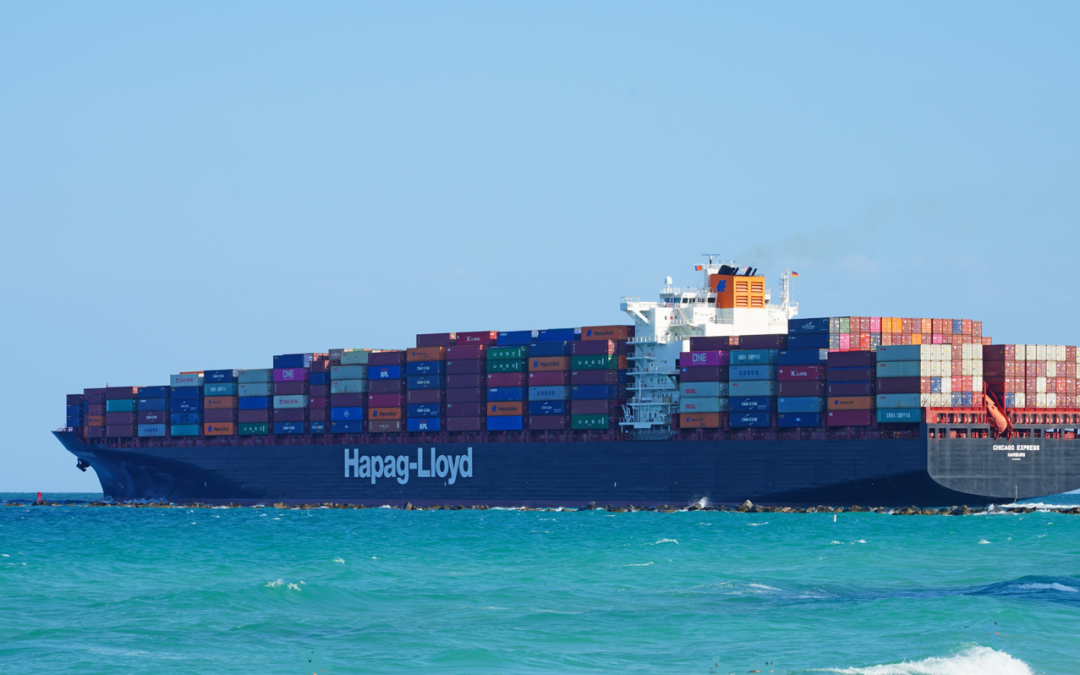The container shipping outlook from Hapag-Lloyd, the world’s fifth-largest liner company: Demand is moderating, spot freight rates should keep ticking lower, and congestion — currently very high — should abate. But demand is not collapsing. Congestion in some regions, such as the U.S. East Coast, is more stubborn than in others. And higher contract rates will offset spot rate declines, leading to near-record second-half profits.
Container shipping demand
“The U.S. consumer seems to be holding up reasonably well,” Hapag-Lloyd CEO Rolf Habben Jansen said during a conference call on Thursday. “If you look at the first half, trans-Pacific volumes were growing [year on year], which is remarkable given the steep increases we saw in 2021 versus 2020.”
According to CFO Mark Frese, “Currently, markets are talking intensively about weakening demand. But despite all the bad news, demand remained robust in the reporting period [Q2].”
Commenting on import demand as of today, halfway through Q3, Habben Jansen said: “We see U.S. demand holding up, whereas certainly in Europe and some other places there’s probably more nervousness and uncertainty. We don’t see demand falling off a cliff — anywhere.”
However, he does see “a fairly material easing of demand” compared with the peak. “We definitely see signs of the economy cooling down, which will help markets normalize in the months and quarters to come.
“We used to be multiple times oversubscribed on every ship system; we are still oversubscribed today but not as strongly anymore. That’s why you see the spot rates coming down. It’s not like there is no tension whatsoever. But there are certainly signs that the market is easing somewhat. We see that in the bookings and quotations being requested.”
Container shipping spot rates
Hapag-Lloyd secured an average rate of $5,870 per forty-foot equivalent unit in Q2 2022, up 71% from the year before and its highest quarterly average ever.
Its average rates rose 6% sequentially versus the first quarter, during a time when the Shanghai Containerized Freight Index, which measures spot rates, dropped 26%. The rise in Hapag-Lloyd’s average rates was driven by higher annual and multiyear contract rates, said Frese.
According to Habben Jansen, 45%-50% of Hapag-Lloyd’s business is under contract. He expects spot rates on the remaining 50%-55% to continue their decline through the second half, although he noted that “by historical standards, spot rates are still at very high levels.”
The company’s full-year guidance implies contract rates will continue to support average rates. Hapag-Lloyd expects earnings before interest, taxes, depreciation and amortization of $8.6 billion-$10.6 billion in the second half, with Q3 stronger than Q4. The upper end of its second-half guidance is close to the $10.9 billion in EBITDA in the record-breaking first half, implying ongoing market strength.
“The exceptional freight rate environment continues to be the main driver of our financial performance,” said Frese.
Congestion easing at some ports, but not on East Coast
Port congestion is helping to support rates by tying up ships, removing effective transport capacity from the freight market.
Clarksons’ container shipping congestion index is now close to its all-time high. According to Hapag-Lloyd, the index jumped 53% for the U.S. East Coast in Q2 2022 versus Q1 2022, with China up 28%, Northern Europe up 26% and the U.S. West Coast down 14%.
“I don’t think this shows the entire picture,” said Habben Jansen of the Clarksons index.
“We do see some signs of things easing. The U.S. West Coast has clearly improved. The Med is running fairly smoothly. Asia has clearly improved compared to a couple of months ago. Container availability is clearly better than it was some months ago. So, I would expect this congestion index is going to show an improvement over the months to come.
“The real issues now are on the U.S. East Coast and in [Northern] Europe,” he said. On the East Coast, “things are not deteriorating but they are not improving.” In Europe, congestion “is being driven by labor tensions at a number of big ports. Once that’s behind us, I’d expect to see further easing there.”
Advantage goes to cargo shippers in 2023-2024
The wind-down of congestion — when it finally happens — will release more ships into the market. A wave of newbuild deliveries will inject even more capacity in 2023-2024.
“We have seen the orderbook going up further,” said the Hapag-Lloyd CEO. “Right now it’s at about 28% of the global fleet [the percentage of capacity on order versus capacity on the water]. That’s quite high. It’s a very significant orderbook, which means we will get quite a lot of new vessels in the fleet going forward.
“How much of that will be absorbed by demand or by new environmental regulations or [offset] by increased scrapping remains to be seen,” he said. New environmental rules that might effectively require lower speeds could reduce capacity by 5%-10% in 2023-24, he said. (Competitor Maersk estimates a higher potential: 5%-15%.)
In addition, ships kept in extended service by boom-era rates will be put into drydock for maintenance when more capacity is available. “It will create more space to catch up on some of the drydockings that need to be done,” said Habben Jansen.
But overall, Hapag-Lloyd expects container shipping’s future market balance to tip in favor of cargo shippers. After several years of import demand outpacing transport supply, it cited estimates that global fleet capacity will grow 7% in 2023, more than twice the 3% growth rate for demand.
“We clearly see that over the coming 24 months, supply growth will outpace demand growth,” said Habben Jansen.
Source: Hellenic Shipping News






